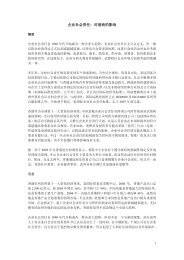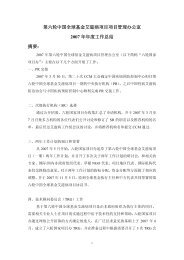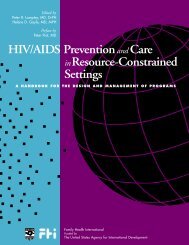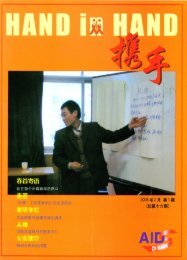The Training of Trainers Manual - UNFPA
The Training of Trainers Manual - UNFPA
The Training of Trainers Manual - UNFPA
You also want an ePaper? Increase the reach of your titles
YUMPU automatically turns print PDFs into web optimized ePapers that Google loves.
Day 5<br />
It is important, therefore, to make sure that all peer educators in the group<br />
begin to increase their confidence and expertise so that they can cover all<br />
<strong>of</strong> the topics taught by your group. How can you make sure this happens<br />
In an ideal world, you would train the group to a point at which you could<br />
randomly select any <strong>of</strong> the topics, and a peer educator could demonstrate<br />
how to teach the topic right away. You can teach them early in the training<br />
that they are responsible for learning everything required in the programme,<br />
perhaps by establishing a certification/qualifying test for which they can<br />
prepare. Your group may appreciate receiving a certificate marking their<br />
completion <strong>of</strong> the training, since this will demonstrate an accomplishment<br />
about which they can feel pride and which will increase their self-esteem.<br />
As a trainer, you are likely to find yourself having to monitor and respond to the<br />
way in which peer educators behave towards one another. As with any group,<br />
interpersonal tensions may erupt. It is also common for cliques to form within a<br />
peer group. If the programme is well structured from the beginning, the use <strong>of</strong><br />
trust-building and team-building exercises will be incorporated into the training.<br />
During the training, the facilitator should randomly assign participants to small<br />
groups and activities, so that the trainees gain maximum exposure to each other.<br />
This may help reduce the tendency for sub-groups or cliques to form. When peer<br />
educators have more opportunities to discover things they like about each other,<br />
there may also be fewer tendencies for cliques to exclude someone or treat a<br />
participant in a negative way.<br />
Retention<br />
Turnover, when peer educators leave the project, is to be expected once peer educators or trainers<br />
complete their contract and fulfil program expectations. Managers and trainers can help increase<br />
rates <strong>of</strong> retention by good recruitment and management and also by providing regular feedback,<br />
information, and incentives. Identifying low cost ways to retain or keep peer educators in programs<br />
should be considered an essential part <strong>of</strong> any training program. Strong youth-adult partnerships can<br />
assist in retention, including working with parents, community stakeholders, and program staff.<br />
Section 2. Guidelines for <strong>Training</strong> <strong>of</strong> <strong>Trainers</strong><br />
103

















